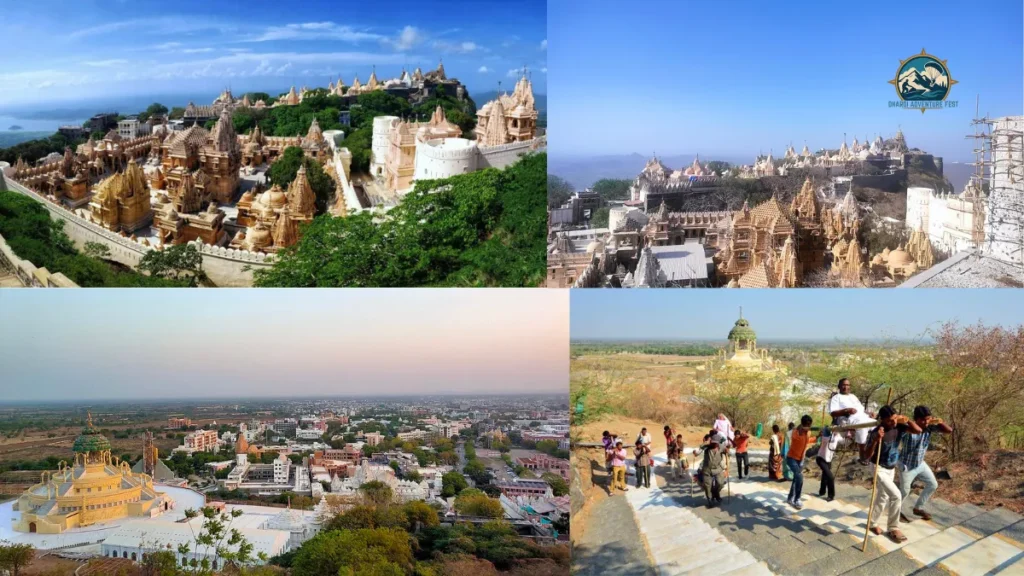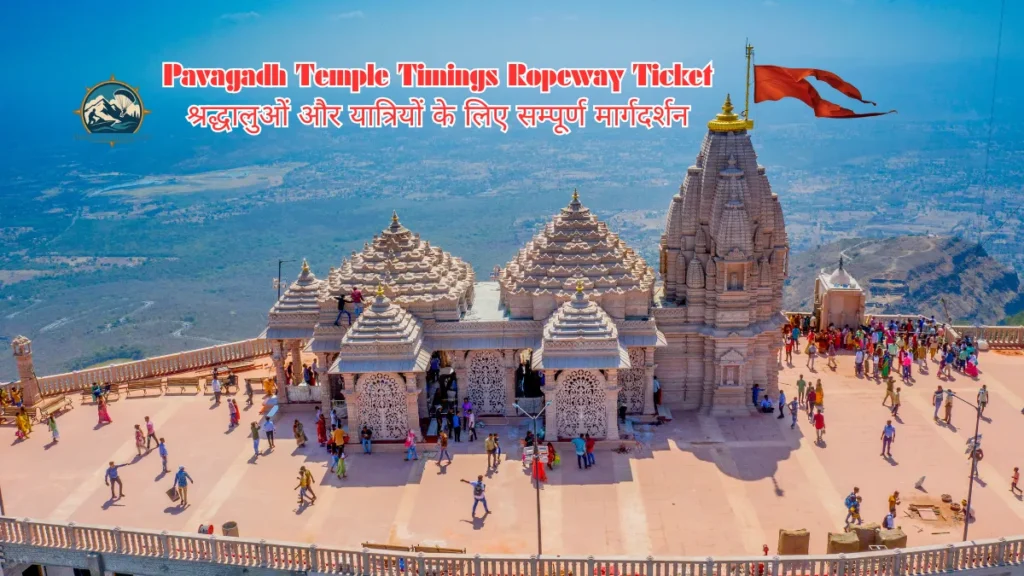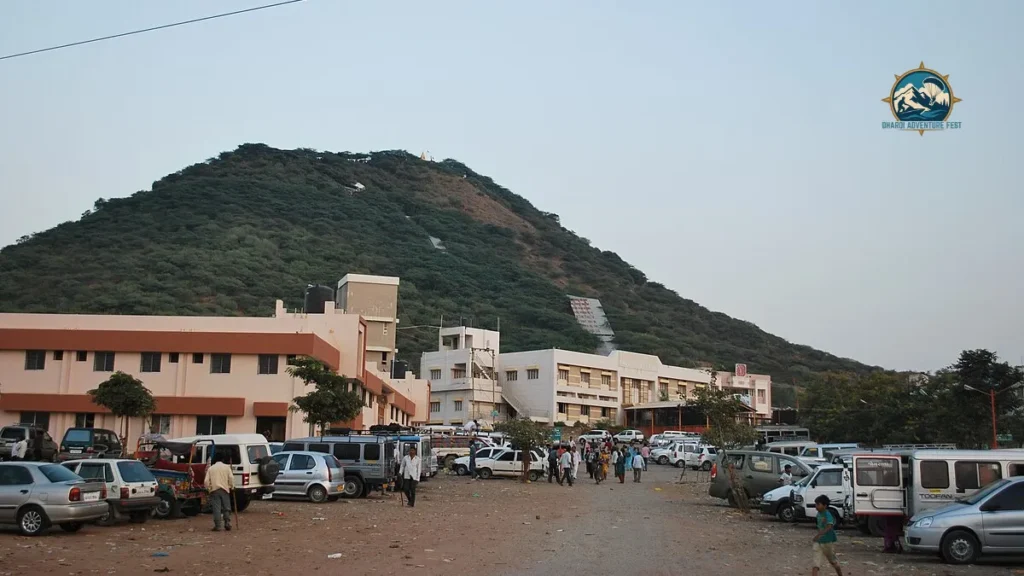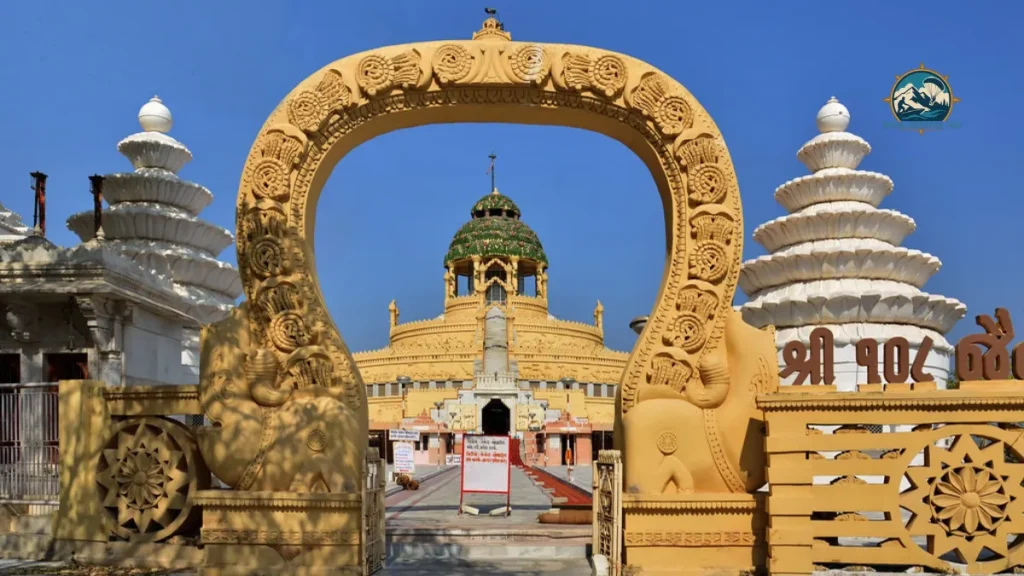The History of Shatrunjay Tirth is one of the most fascinating and revered chapters in Jainism. Located in Palitana, Gujarat, the Shatrunjay hills host over 1,300 exquisitely carved marble temples, making it one of the most sacred pilgrimage destinations for the Jain community. At the summit of the hills stands the main temple dedicated to the first Tirthankar, Lord Adinath (Rishabdeva), an emblem of spiritual enlightenment and devotion. This pilgrimage site is not only a center of faith but also a magnificent example of Jain art and architecture.
Presiding Deity and Location
The presiding deity of the Shatrunjay Tirth is Sri Adishwar Bhagwan, a serene, white-colored idol seated in a lotus posture, measuring 2.16 meters in height. This divine image is housed in a mountain shrine, located approximately 6 kilometers from the town of Palitana (historically known as Padaliptapur), on the banks of the Shetrunji River. Pilgrims ascend nearly 4 kilometers along a well-maintained path to reach the hilltop temples, a journey that symbolizes devotion, discipline, and spiritual elevation.
Palitana, in the context of reverence and artistry, stands at the pinnacle of Jain pilgrimage. Although there are sacred sites in various parts of India, all paths of devotion converge upon Palitana. This sacred land has witnessed countless saints, ascetics, and devout souls attaining supreme salvation. Every pebble, every grain of soil is considered holy, believed to erase the sins accumulated over lifetimes. Devotees, and even the gods, are said to yearn for a chance to anoint themselves with the soil of Palitana, highlighting its unparalleled sanctity.
Importance in Jainism
Few Jains have not undertaken a pilgrimage to Palitana at least once in their lifetime. It is widely believed that a devout Jain’s life remains incomplete without visiting Palitana and Sammed Shikhar. As the apex of Jain pilgrimage, Palitana is perennially crowded with devotees. Its fame has reached far beyond India, attracting tourists who come not just to sightsee but to offer their reverence and witness the spiritual grandeur of the site.
Palitana is also the largest center for Jain ascetics. Pilgrims often encounter numerous monks and nuns, who themselves embody a living form of pilgrimage. The combination of immovable temples and mobile ascetics enhances the spiritual merit of visiting this holy site. Along the main 5 km road of Palitana city, one finds rows of dharmshalas (charitable boarding houses) and numerous temples, creating a continuous spiritual environment from the town to the foot of the hill.
The Temples and Pilgrimage Experience
The journey to Shatrunjay Tirth begins at the foot of the hill, where devotees are immediately immersed in an atmosphere of devotion. The ascent involves climbing 3,364 steps through pristine pathways surrounded by natural beauty. As pilgrims progress, the heart fills with gratitude for the divine grace allowing them to visit such a sacred site.
Palitana is often called the “City of Temples”. Its uniqueness is reflected in the fact that it houses over 8,613 temples and nearly 33,000 idols. Nowhere else in the world does such a dense and harmonious cluster of temples exist on a single mountain. The temples convey messages of detachment and spiritual discipline, while the sheer number and serenity of the site create an aura of transcendence.
Notable Temples and Toonks
Among the nine major Toonks (temple clusters) on the hill, the Toonk of Motishah Seth stands out with unmatched splendor. These temples were painstakingly constructed with massive stones, showcasing both devotion and extraordinary craftsmanship. Devotees also perform Navanu Yatra, visiting the pilgrimage site 99 times, following the footsteps of Lord Rishabhdev, who is believed to have visited Shatrunjay 99 times himself.
Other significant Toonks include:
- Seth Narshi Keshav Toonk: Built in Samvat 1921, dedicated to Tirthankar Shantinath.
- Khartarwasahi (Chaumukhji) Toonk: The highest Toonk on the hill, featuring four idols of Lord Aadinath facing all directions.
- Chhepawasahi Toonk: Constructed by the Chheepa brothers in Samvat 1791, with Lord Rishabhdev as the principal deity.
- Saakarwasahi Toonk: Built by Seth Saakarchand Premchand, housing four immortal Jineshwars.
- Heemwasahi Toonk: Constructed by Heema Bhai in Samvat 1886, with Lord Ajitnath as the principal deity.
- Premwasahi Toonk: Built by Modi Shree Premchandra Lavjee, dedicated to Lord Rishabhdev.
- Balawasahi Toonk: Renovated in Samvat 1193 by Bala Bhai, dedicated to Lord Aadinath.
- Motishah Toonk: Built by Seth Motishah and consecrated by his son Khemchand in Samvat 1893.
- Additional temples: Near Premwasahi Toonk stands an 18-feet high idol of Tirthankar Aadinath in Padmasan, known as Adbhut Baba.
The main Toonk houses the principal idol of Lord Rishabhdev, a white-colored deity of 2.16 meters. Pilgrims experience overwhelming devotion simply by beholding this idol. Behind the temple stands the ancient Rayan Tree, under which Lord Adinath is believed to have undertaken intense penance.
Rituals and Spiritual Practices
Palitana is a center for rigorous spiritual practices. One of the most important is Varshee-tap, a year-long penance observed by thousands of Jains annually. This involves fasting on one day and consuming food the next, continuing for an entire year. The conclusion of this penance, known as Parna, is particularly auspicious at Palitana. These practices highlight the ascetic discipline central to Jainism.
Pilgrims also visit various kunds (sacred water tanks) like Kumarpal-Kund and Sala-Kund, which hold spiritual significance. Temples on the mountain’s twin summits, nearly 600 meters above sea level, are aligned systematically. From a distance, the row of temples resembles the letter ‘S’, symbolizing the path to detachment and enlightenment.
Historical Significance
Palitana, historically known as Padaliptapur, is also called Shatrunjaya – meaning “Vanquisher of enemies.” Scriptures mention over 100 names for this pilgrimage, including Pundarik Giri, Vimalachal, and Siddhachal. Its history predates the advent of Lord Rishabhdev in the third Kalp of the present time cycle. Even Chakravarti Bharat, the son of Lord Rishabhdev, is believed to have repaired and enhanced the site. Over time, many wealthy patrons and royal figures undertook renovations, including Maharaja Sagar, Lord Shriram, and even the Pandavas. Sixteen major restoration projects are documented, reflecting the enduring devotion to this pilgrimage.
Annual Festivals and Fairs
Palitana hosts several prominent fairs, attracting thousands of devotees. Key festivals include:
- Kartik Poornima
- Falgun Shukla Trayodashi
- Chaitra Poornima
- Baishakh Shukla Tritiya
- Baishakh Krishna Six: Commemorating the consecration of Lord Aadinath in the main Toonk.
During Falgun Shukla Trayodashi, over one lakh devotees walk in processions spanning 10 kilometers. These gatherings highlight the spiritual and cultural significance of the pilgrimage.
Architectural and Artistic Splendor
The temples of Shatrunjay Tirth display unparalleled artistry. Each structure is adorned with intricate carvings, 1245 pitchers, 21 lion idols, 72 dev-kulikas, 32 toranas, and representations of yoginis and digpals. The circular passageways of the main Toonk symbolize knowledge, faith, and conduct, guiding devotees through temples such as Sahasrakund Temple, Samavasaran Temple, Astapad, and Gandhariya Chowmukhi Temple.
The site also includes smaller, yet significant temples like Saraswatidevi Temple, installed in 1860, where devotees, including school children, are introduced to spiritual practices. The Samavasaran Temple contains 108 idols of Tirthankaras, serving as a miniature university for scholars and devotees alike.
Pilgrimage Journey Highlights
As pilgrims ascend the mountain, they pass through numerous iconic points:
- Rampol and Sagalpol: Gateway structures with artistic carvings and resting places.
- Hathipol: Featuring stone elephants and the temple of Bhagawan Adishwar.
- Paap-Punya Window: Also called the Moksha-window, where pilgrims symbolically overcome sins.
- Mini-Shetrunjaya: A replica with nine peaks for devotees unable to climb the mountain.
The journey, involving 3,364 steps and an elevation of 2,000 feet, is arduous yet spiritually rewarding. Pilgrims are often overwhelmed by a sense of divine presence, the artistry of temples, and the natural beauty surrounding them.
Key Facts at a Glance
| Feature | Details |
|---|---|
| Steps to climb | 3,364 |
| Height of hill | 2,000 ft |
| Total Pratima (Idols) | 27,007 |
| Jinmandir | 3,507 |
| Pagla | 1,500 |
| Main deity | Lord Adinath (Rishabhdev) |
| Famous Toonks | Motishah, Khartarwasahi, Chhepawasahi, Saakarwasahi, Heemwasahi, Premwasahi, Balawasahi, etc. |
| Major fairs | Kartik Poornima, Falgun Shukla Trayodashi, Chaitra Poornima, Baishakh Shukla Tritiya, Baishakh Krishna Six |
Also read: Shatrunjay Hill Palitana – भारत का पावन जैन तीर्थस्थल
Conclusion: History of Shatrunjay Tirth
The History of Shatrunjay Tirth is a testament to the devotion, discipline, and artistic excellence of Jainism. From its presiding deity Lord Adinath to the intricate carvings of countless temples, from annual festivals to rigorous spiritual practices, Palitana remains a beacon of faith and culture. It is not just a pilgrimage; it is an experience that inspires, educates, and elevates the soul.
Whether through the grand Toonk of Motishah Seth, the serenity of the Rayan Tree, or the stunning vistas of the twin summits, every aspect of Shatrunjay Tirth reflects an extraordinary confluence of devotion, art, and history. For Jains and spiritual seekers worldwide, a visit to Palitana is the ultimate journey, offering a glimpse of divine grace, spiritual liberation, and timeless tradition.




